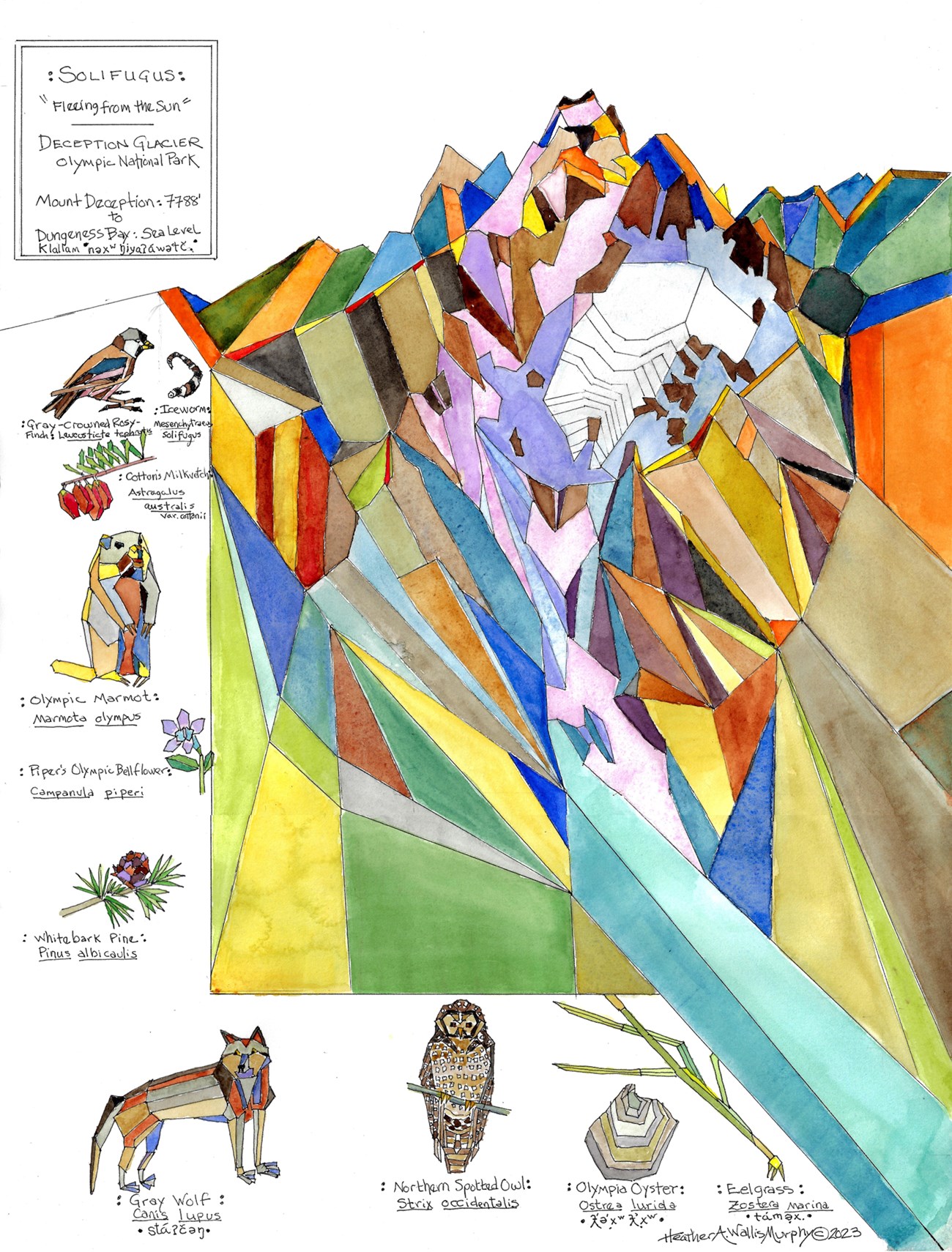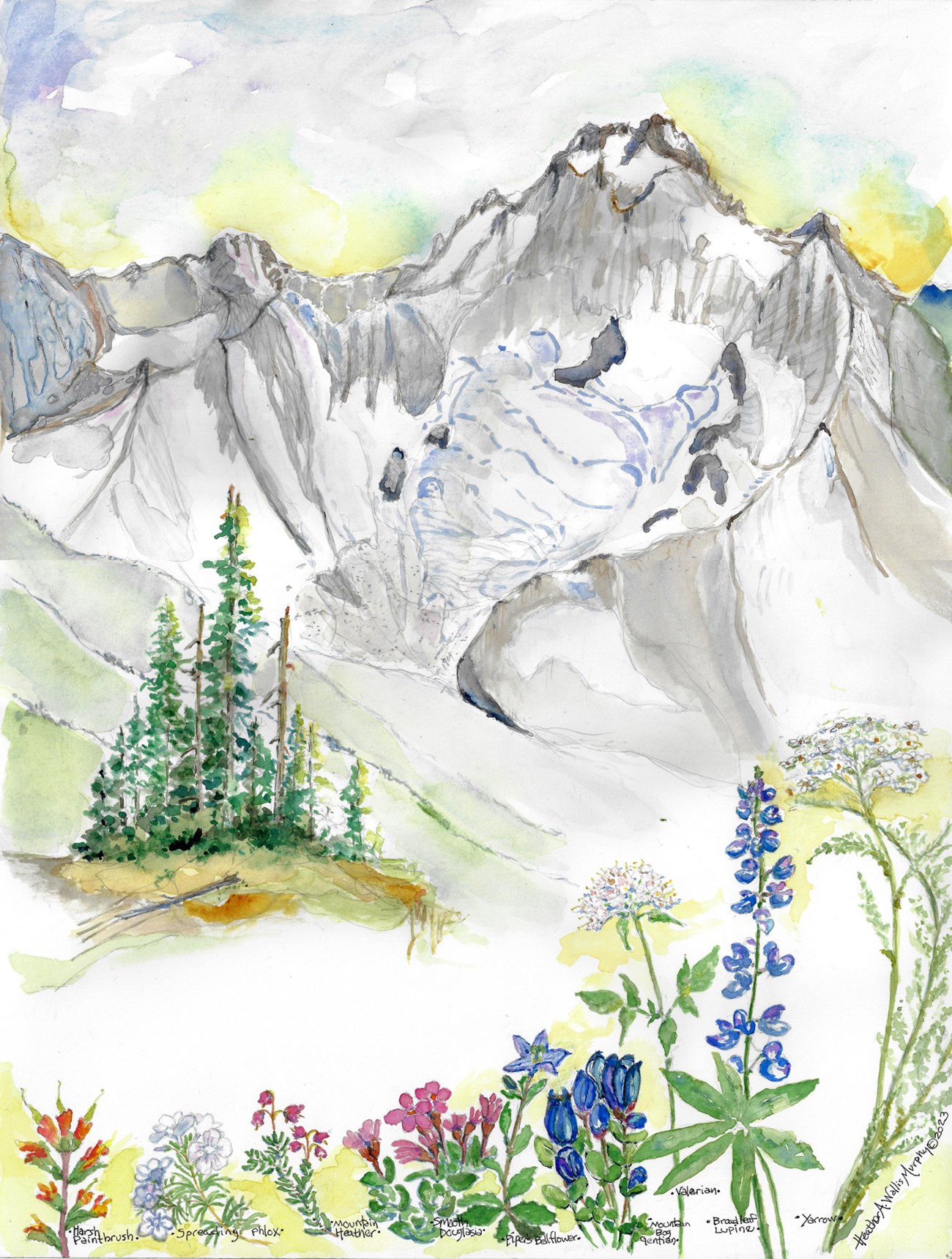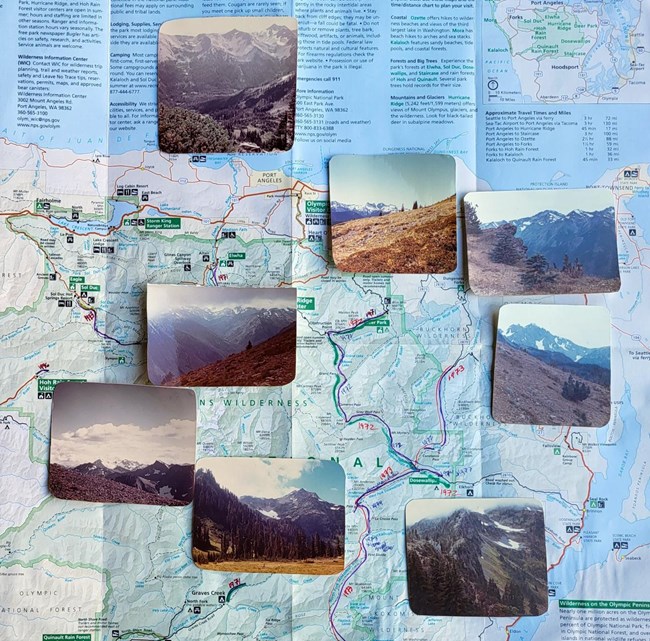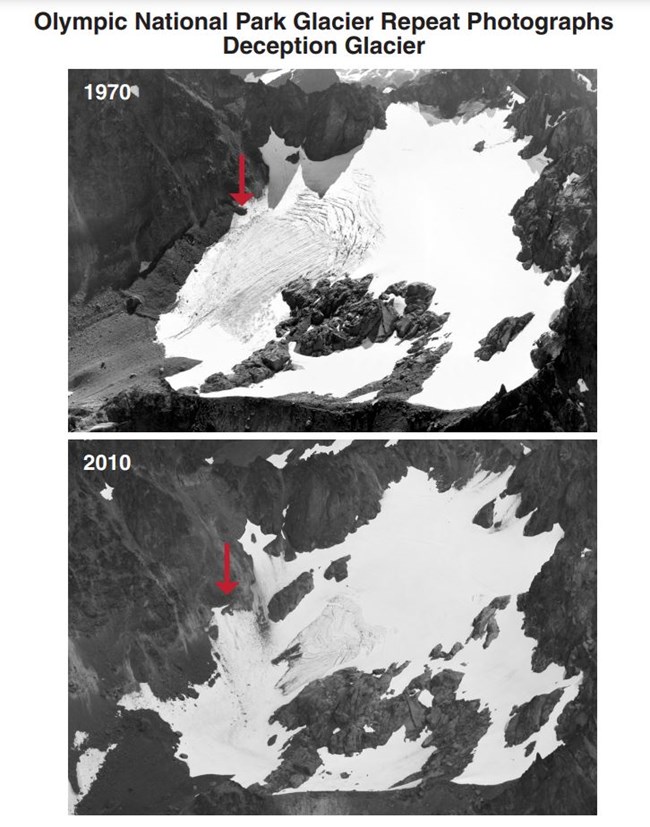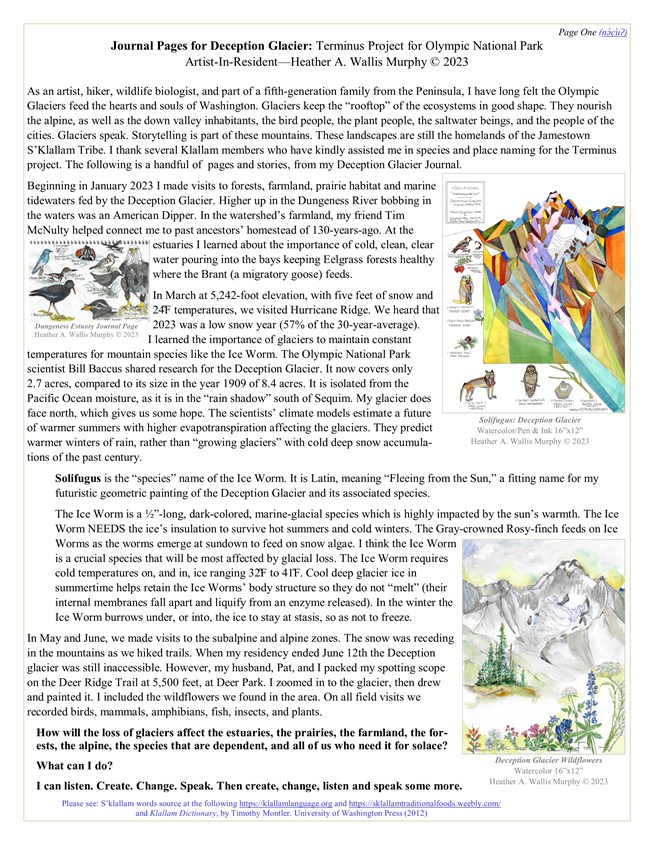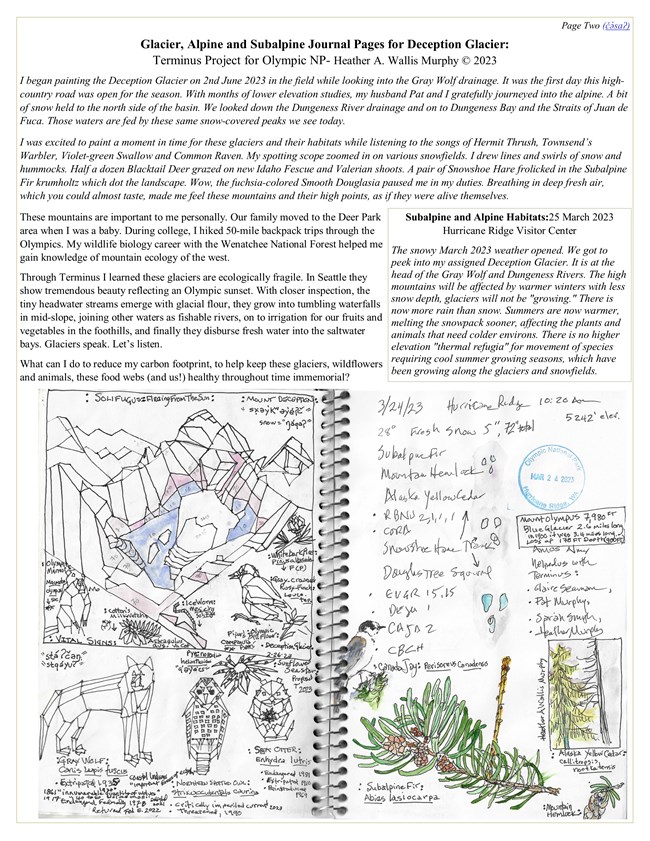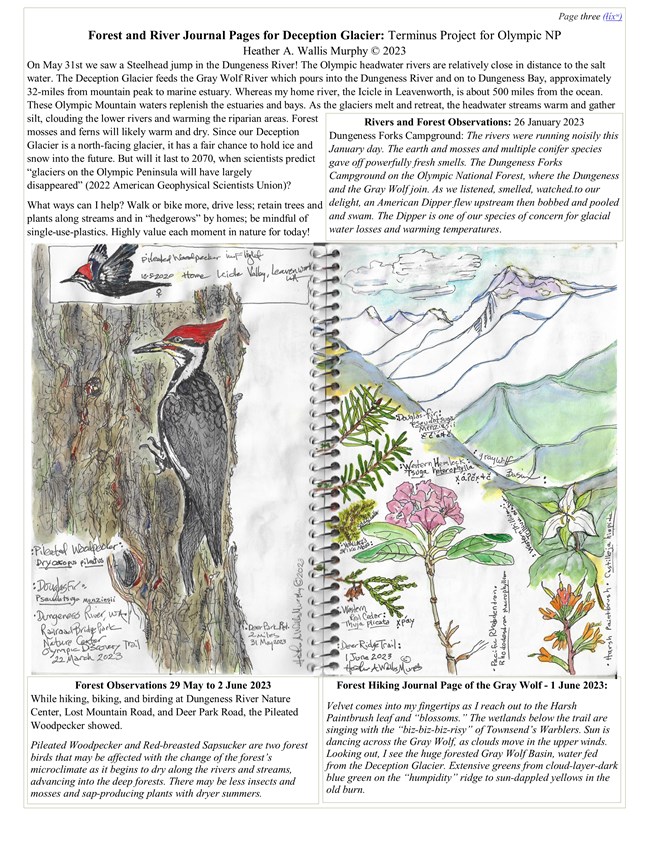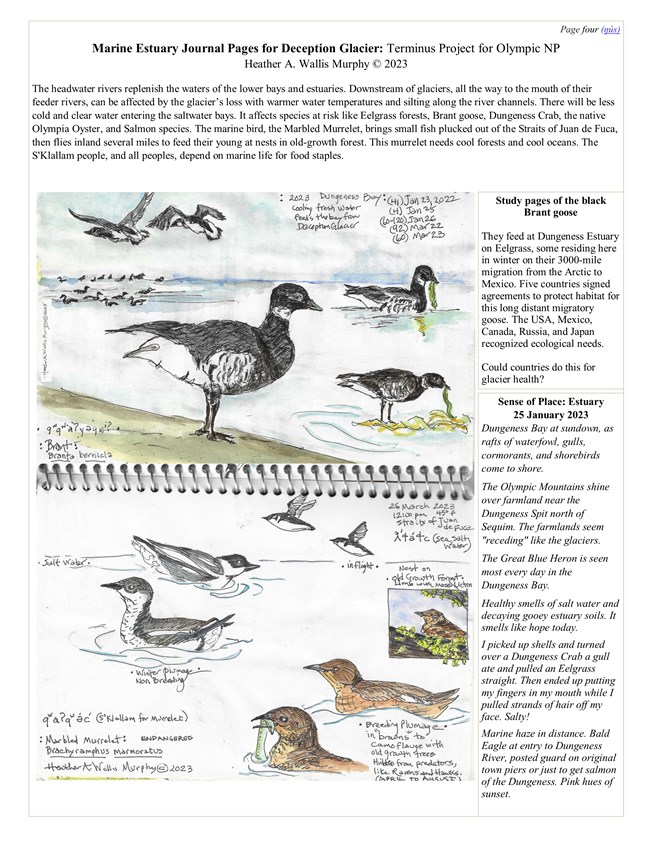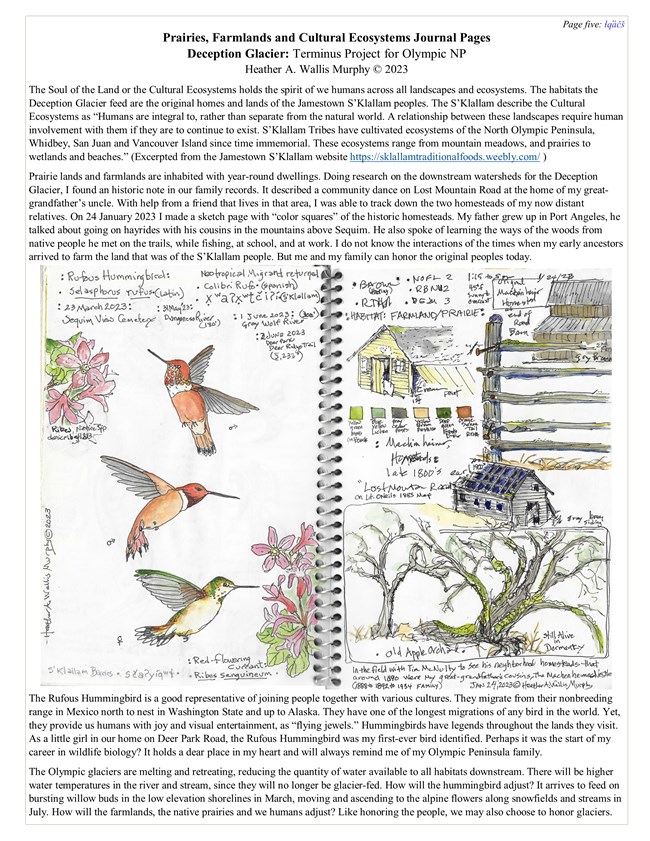Pages in watercolor painting with both print and hand-written text.
Page 1
IMAGES: One notebook page with watercolor paintings of birds, labeled "Dungeness Estuary Journal Page".
:An angular, abstract representation of a mountain, made up of geometric shapes in many different colors. A glacier lies at the center of the mountain, and images of plants and animals in a similar style surround the mountain. Handwritten text labels the piece: “:Solifugus: ‘Fleeing from the sun.’ Deception Glacier, Olympic National Park. Mount Deception = 7788’ to Dungeness Bay: Sea Level. Klallam
A watercolor mountain with a glacier tucked below its peak. A stand of evergreen trees is clustered below, and in the foreground, a row of different wildflowers labeled Marsh Paintbrush (with brilliant red-orange flowers), Spreading Phlox (pale blue-purple flowers), Mountain Heather (small pink bell-like flowers atop short-leaved, branching stalks), Smooth Douglasia (pink, round-petaled flowers with orange centers), Piper’s Bellflower (purplish-blue and star-shaped), Mountain Bog Gentian (blue with petals forming an upright, cup shape), Valerian (small white flowers clustered atop a stalk, with long stamens), Broadleaf Lupine (blue purple blossoms around the length of a tall stalk), and Yarrow (a cluster of small white flowers atop a long stalk, with long, feathering leaves). The painting is signed Heather A. Wallis Murphy © 2023.
TEXT:
Journal Pages for Deception Glacier: Terminus Project for Olympic National Park
Artist-In-Resident—Heather A. Wallis Murphy © 2023
As an artist, hiker, wildlife biologist, and part of a fifth-generation family from the Peninsula, I have long felt the Olympic Glaciers feed the hearts and souls of Washington. Glaciers keep the “rooftop” of the ecosystems in good shape. They nourish the alpine, as well as the down valley inhabitants, the bird people, the plant people, the saltwater beings, and the people of the cities. Glaciers speak. Storytelling is part of these mountains. These landscapes are still the homelands of the Jamestown S’Klallam Tribe. I thank several Klallam members who have kindly assisted me in species and place naming for the Terminus project. The following is a handful of pages and stories, from my Deception Glacier Journal.
Beginning in January 2023 I made visits to forests, farmland, prairie habitat and marine tidewaters fed by the Deception Glacier. Higher up in the Dungeness River bobbing in the waters was an American Dipper. In the watershed’s farmland, my friend Tim McNulty helped connect me to past ancestors’ homestead of 130-years-ago. At the estuaries I learned about the importance of cold, clean, clear water pouring into the bays keeping Eelgrass forests healthy where the Brant (a migratory goose) feeds.
In March at 5,242-foot elevation, with five feet of snow and 24̊F temperatures, we visited Hurricane Ridge. We heard that 2023 was a low snow year (57% of the 30-year-average). I learned the importance of glaciers to maintain constant temperatures for mountain species like the Ice Worm. The Olympic National Park scientist Bill Baccus shared research for the Deception Glacier. It now covers only 2.7 acres, compared to its size in the year 1909 of 8.4
acres. It is isolated from the Pacific Ocean moisture, as it is in the “rain shadow” south of Sequim. My glacier does face north, which gives us some hope. The scientists’ climate models estimate a future of warmer summers with higher evapotranspiration affecting the glaciers. They predict warmer winters of rain, rather than “growing
glaciers” with cold deep snow accumulations of the past century.
Solifugus is the “species” name of the Ice Worm. It is Latin, meaning “Fleeing from the Sun,” a fitting name for my futuristic geometric painting of the Deception Glacier and its associated species. The Ice Worm is a 1⁄2”-long, dark-colored, marine-glacial species which is highly impacted by the sun’s warmth. The Ice Worm NEEDS the ice’s insulation to survive hot summers and cold winters. The Gray-crowned Rosy-finch feeds on
Ice Worms as the worms emerge at sundown to feed on snow algae. I think the Ice Worm is a crucial species that will be most affected by glacial loss. The Ice Worm requires cold temperatures on, and in, ice ranging 32̊F to 41̊F. Cool deep glacier ice in summertime helps retain the Ice Worms’ body structure so they do not “melt” (their internal membranes fall apart and liquify from an enzyme released). In the winter the Ice Worm burrows under, or into, the ice to stay at stasis, so as not to freeze.
In May and June, we made visits to the subalpine and alpine zones. The snow was receding in the mountains as we hiked trails. When my residency ended June 12th the Deception glacier was still inaccessible. However, my husband, Pat, and I packed my spotting scope on the Deer Ridge Trail at 5,500 feet, at Deer Park. I zoomed in to the glacier, then drew and painted it. I included the wildflowers we found in the area. On all field visits we recorded birds, mammals, amphibians, fish, insects, and plants.
How will the loss of glaciers affect the estuaries, the prairies, the farmland, the forests, the alpine,
the species that are dependent, and all of us who need it for solace?
What can I do?
I can listen. Create. Change. Speak. Then create, change, listen and speak some more.
Please see: S’klallam words source at the following https://klallamlanguage.org and https://sklallamtraditionalfoods.weebly.com/
and Klallam Dictionary, by Timothy Montler. University of Washington Press (2012)
Page 2
A wirebound notebook lies open, two facing pages visible. The first features a mountain glacier and various animals drawn in ink, their shapes geometric rather than realistic, labeled SOLIFUGUS = Fleeing From The Sun MOUNT DECEPTION
Mountain = sx ̣əy̕kwəy̕éʔč Snow = ŋáqaʔ
Olympic Marmot, Marmota Olympus Whitebark Pine, Pinus albicula
Cotton’s Milkvetch, Astragalus australis (var. cottonii) Gray-crowned Rosy-Finch, Leucosticte tephrocotis
Ice Worm, Mesenchytraeus solifugus Piper’s Olympic Bellflower, Campanula piperi
Sunflower Sea Star, proposed (listing) T. 2023
VITAL SIGNS Pycnopodia helianthoides = q̕əy̕ács
Wolf = stáʔčəŋ; stqáyuʔ Northern Spotted Owl, Strix occidentalis caurina
Gray Wolf, Canis lupus fuscus Critically imperiled, current 2023.
Coastal Indians “Important forces in the Ecosystem” Threatened 1990.
Extirpated 1920-1935 Sea Otter, Enhydra lutris.
1861 “innumerable quantity of wolves” Endangered 1981.
1917 “40 to 60 on Olympic Peninsula” Extirpated 1910.
Endangered Federally 1978. Reintroduced 1969.
Delisted 2021. Returned Federally Endangered 2022
The second page features more realistic drawings of a bird labeled "Canada Jay", a tree branch labeled "subalpine fir", a cone labeled "Mountain Hemlock," and a pair of trees side by side, one covered in greenery, the other bare, labeled "Alaska Yellow Cedar." The journal page is dated 3/24/23 Hurricane Ridge, 10:30 AM. 5242 elev. Handwriting: "28 degrees, fresh snow 5 inches, 72 inchges total. The page is stamped with a passport style stamp with the date "Mar 24 2023, Olympic Nationla Park, Hurricane Ridge, WA". The handwriting goes on to list species and names.
TEXT:
Glacier, Alpine and Subalpine Journal Pages for Deception Glacier:
Terminus Project for Olympic NP - Heather A. Wallis Murphy © 2023
I began painting the Deception Glacier on 2nd June 2023 in the field while looking into the Gray Wolf drainage. It was the first day this high-country road was open for the season. With months of lower elevation studies, my husband Pat and I gratefully journeyed into the alpine. A bit of snow held to the north side of the basin. We looked down the Dungeness River drainage and on to Dungeness Bay and the Straits of Juan de Fuca. Those waters are fed by these same snow-covered peaks we see today.
I was excited to paint a moment in time for these glaciers and their habitats while listening to the songs of Hermit Thrush, Townsend’s Warbler, Violet-green Swallow and Common Raven. My spotting scope zoomed in on various snowfields. I drew lines and swirls of snow and hummocks. Half a dozen Blacktail Deer grazed on new Idaho Fescue and Valerian shoots. A pair of Snowshoe Hare frolicked in the Subalpine Fir krumholtz which dot the landscape. Wow, the fuchsia-colored Smooth Douglasia paused me in my duties. Breathing in deep fresh air, which you could almost taste, made me feel these mountains and their high points, as if they were alive themselves.
These mountains are important to me personally. Our family moved to the Deer Park area when I was a baby. During college, I hiked 50-mile backpack trips through the Olympics. My wildlife biology career with the Wenatchee National Forest helped me gain knowledge of mountain ecology of the west.
Through Terminus I learned these glaciers are ecologically fragile. In Seattle they show tremendous beauty reflecting an Olympic sunset. With closer inspection, the tiny headwater streams emerge with glacial flour, they grow into tumbling waterfalls in mid-slope, joining other waters as fishable rivers, on to irrigation for our fruits and vegetables in the foothills, and finally they disburse fresh water into the saltwater bays. Glaciers speak. Let’s listen.
What can I do to reduce my carbon footprint, to help keep these glaciers, wildflowers and animals, these food webs (and us!) healthy throughout time immemorial?
Subalpine and Alpine Habitats:25 March 2023
Hurricane Ridge Visitor Center
The snowy March 2023 weather opened. We got to peek into my assigned Deception Glacier. It is at the head of the Gray Wolf and Dungeness Rivers. The high mountains will be affected by warmer
winters with less snow depth, glaciers will not be "growing." There is now more rain than snow. Summers are now warmer, melting the snowpack sooner, affecting the plants and animals that need colder environs. There is no higher elevation "thermal refugia" for movement of species requiring cool summer growing seasons, which have been growing along the glaciers and snowfields.
Page 3
IMAGES: A wirebound notebook lies open, two facing pages visible.The first features watercolor paintings of woodpeckers and handwritten notes:
Pileated Woodpecker in Flight
10-5-2020 home Icicle Valley, Leavenworth WA
Female
Pileated Woodpecker
Dryocopus pileatus
Douglas Fir
Pseudotsuga menziesii
Dungeness River, WA. Railroad Bridge Park
Nature Center, Olympic Discovery Trail.
22 March 2023
Deer Park Road. 2-miles. 31 May 2023
The second page is watercolors of a mountain landscape and several plant species. Notes read:
Pseudotsuga menziesii
čč̕ á̕ ɬč
Western Hemlock Gray Wolf Basin
Tsuga heterophylla
x ̣áʔčx ̣ɬč
Wallace’s Spike Moss Pacific Rhododendron
Selaginella wallacei Rhododendron macrophyllum
Western Trillium
Trillium ovatum
Harsh Paintbrush
Castilleja hispida
Deer Ridge Trail, 1 June 2023
TEXT:
Rivers and Forest Observations: 26 January 2023 Dungeness Forks Campground: The rivers were running noisily this January day. The earth and mosses and multiple conifer species gave off powerfully
fresh smells. The Dungeness Forks Campground on the Olympic National Forest, where the Dungeness and the Gray Wolf join. As we listened, smelled, watched.to our delight, an American Dipper flew upstream then bobbed and pooled and swam. The Dipper is one of our species of concern for glacial water losses and warming temperature.
Forest Observations 29 May to 2
June 2023
While hiking, biking, and birding at Dungeness River Nature Center, Lost
Mountain Road, and Deer Park Road the Pileated Woodpecker showed.
Pileated Woodpecker and Red- breasted Sapsucker are two forest birds that may be affected with the
change of the forests microclimate as it begins to dry along the rivers and streams, advancing into the
deep forests. There may be less insects and mosses and sap producing plants with dryer summers.
On May 31st we saw a Steelhead jump in the Dungeness River! The Olympic headwater rivers are relatively close in distance to the salt water. The Deception Glacier feeds the Gray Wolf River which pours into the Dungeness River and on to Dungeness Bay, approximately 32-miles from mountain peak to marine estuary. Whereas my home river, the Icicle in Leavenworth, is about 500 miles from the ocean. These Olympic Mountain waters replenish the estuaries and bays. As the glaciers melt and
retreat, the headwater streams warm and gather silt, clouding the lower rivers and warming the riparian areas. Forest mosses and ferns will likely warm and dry. Since our Deception Glacier is a north-facing glacier, it has a fair chance to hold ice and
snow into the future. But will it last to 2070, when scientists predict “glaciers on the Olympic Peninsula will have largely disappeared” (2022 American Geophysical Scientists Union)?
What ways can I help? Walk or bike more, drive less; retain trees and plants along streams and in “hedgerows” by homes; be mindful of single-use-plastics. Highly value each moment in nature for today!
Page 4
IMAGES: Two pages of a wirebound journal laid open, turned sideways. Both pages feature watercolor paintings of different bird species, and handwritten notes.
2023 Dungeness Bay (41) Jan 23, 2022(2023)
Cooling fresh water (4) Jan 25
Feeds the bay from (60-120) Jan 26
Deception Glacier (92) Mar 2022
(60) Mar 203
qwqwáʔyəqwiʔ
Brant
Branta bernicla
26 March 2023
12:00 pm 45̊f
Straits of Juan de Fuca
ƛ̕ɬáɬc (Sea, Salt Water)
Salt Water in flight Nest on Old Growth Forest.
Limb with moss/lichen
Winter Plumage, Non Breeding
qwaʔqwə́c̕(S’Klallum for Murrelet) Breeding Plumage
Marbled Murrelet: ENDANGERED in “browns” to
Brachyramphus marmoratus camouflage with
\ old growth trees
from predators, like ravens and hawk
(April to August)
TEXT:
Study pages of the black Brant goose
They feed at Dungeness Estuary on Eelgrass, some residing here in winter on their 3000-
mile migration from the Arctic to Mexico. Five countries signed agreements to protect habitat for this long distant migratory goose. The USA, Mexico, Canada, Russia, and Japan recognized ecological needs.
Could countries do this for glacier health?
Sense of Place: Estuary
25 January 2023
Dungeness Bay at sundown, as
rafts of waterfowl, gulls,
cormorants, and shorebirds come
to shore.
The Olympic Mountains shine over
farmland near the Dungeness Spit
north of Sequim. The farmlands
seem "receding" like the glaciers.
The Great Blue Heron is seen most
every day in the Dungeness Bay.
Healthy smells of salt water and
decaying gooey estuary soils. It
smells like hope today.
I picked up shells and turned over a
Dungeness Crab a gull ate and
pulled an Eelgrass straight. Then
ended up putting my fingers in my
mouth while I pulled strands of hair
off my face. Salty!
Marine haze in distance. Bald
Eagle at entry to Dungeness River,
posted guard on original town piers
or just to get salmon of the
Dungeness. Pink hues of sunset.
Marine Estuary Journal Pages for Deception Glacier: Terminus Project for Olympic NP
Heather A. Wallis Murphy © 2023
The headwater rivers replenish the waters of the lower bays and estuaries. Downstream of glaciers, all the way to the mouth of their feeder rivers can be affected by the glacier’s loss with warmer water
temperatures and silting along the river channels. There will be less cold and clear water entering the
saltwater bays. It affects species at risk like Eelgrass forests, Brant goose, Dungeness Crab, the native
Olympia Oyster, and Salmon species. The marine bird, the Marbled Murrelet, brings small fish plucked
out of the Straits of Juan de Fuca, they fly inland several miles to nests in old growth forest, feeding their young. This murrelet needs cool forests and cool oceans. The S'Klallam people, and all peoples, depend on marine life for food staples.
Page 5
IMAGES:
A wirebound notebook laid open. The first page features watercolors of hummingbirds and flowers, with handwritten notes:
Rufous Hummingbird Neotropical Migrant returned
Selasphorus rufus (Latin) Colibrí Rufo (Spanish)
23 March 2023 31 May ’23 x ̣waʔxẉ tči̕ ʔí (S’Klallam)
Sequim View Cemetery Dungeness River (180’)
1 June 2023 (3000’)
Gray Wolf River
Ribes, Native Spp 2 June 2023
Described 1813 Deer Park
Deer Ridge Trail (5,233’)
S’Klallam Berries sčaʔyíqwɬ Red-flowering Current
Ribes sanguineum
The second page features watercolor of fences, trees, and a house. Handwritten notes:
BAOW (Hooting) RTHA NOFL 2 RBNU 2 DEJU 3 1:15 to 5:pm 1/24/23
45̊f sunny to overcast
HABITAT: FARMLAND/PRAIRIE Original Machenheimer Homestead
at end of road.
Barn, 2nd Farm, Gray-Brown
Yellow Green Moss on Boards; Blue Yellow Lichen; Gray Cedar Posts; Yellow Brown Pasture;
Deep Green Forests D-Fir, Orange Sienna Tail RTHA
Machenheimer Homestead: late 1800’s early 1900’s.
“Lost Mountain Road” on Lt. Oneils 1885 Map.
Gray Brown Siding
Old Apple Orchard. Still Alive in Dormancy
In the field with Tim McNulty to see his neighborhood homesteads that around 1890 were my great-grandfather’s cousins, the Machenheimer-
Nestles (1888 to 1892 to 1934 FAMILY).
24 January, 2023
TEXT:
Prairies, Farmlands and Cultural Ecosystems Journal Pages
Deception Glacier: Terminus Project for Olympic NP
Heather A. Wallis Murphy © 2023
The Soul of the Land or the Cultural Ecosystems holds the spirit of we humans across all landscapes and ecosystems. The habitats the Deception Glacier feed are the original homes and lands of the Jamestown S’Klallam peoples. The S’Klallam describe the Cultural Ecosystems as “Humans are integral to, rather than separate from the natural world. A relationship between these landscapes require human involvement with them if they are to continue to exist. S’Klallam Tribes have cultivated ecosystems of the North Olympic Peninsula, Whidbey, San Juan and Vancouver Island since time immemorial. These ecosystems range from mountain meadows, and prairies to wetlands and beaches.” (Excerpted from the Jamestown S’Klallam website https://sklallamtraditionalfoods.weebly.com/ )
Prairie lands and farmlands are inhabited with year-round dwellings. Doing research on the downstream watersheds for the Deception Glacier, I found an historic note in our family records. It described a community dance on Lost Mountain Road at the home of my great-grandfather’s uncle. With help from a friend that lives in that area, I was able to track down the two homesteads of my now distant relatives. On 24 January 2023 I made a sketch page with “color squares” of the historic homesteads. My father grew up in Port Angeles, he talked about going on hayrides with his cousins in the mountains above Sequim. He also spoke of learning the ways of the woods from native people he met on the trails, while fishing, at school, and at work. I do not know the interactions of the times when my early ancestors arrived to farm the land that was of the S’Klallam people. But me and my family can honor the original peoples today.
The Rufous Hummingbird is a good representative of joining people together with various cultures. They migrate from their nonbreeding range in Mexico north to nest in Washington State and up to Alaska. They have one of the longest migrations of any bird in the world. Yet, they provide us humans with joy and visual entertainment, as “flying jewels.” Hummingbirds have legends throughout the lands they visit. As a little girl in our home on Deer Park Road, the Rufous Hummingbird was my first- ever bird identified. Perhaps it was the start of my career in wildlife biology? It holds a dear place in my heart and will always remind me of my Olympic Peninsula family.
The Olympic glaciers are melting and retreating, reducing the quantity of water available to all habitats downstream. There will be higher water temperatures in the river and stream, since they will no longer be glacier-fed. How will the hummingbird adjust? It arrives to feed on bursting willow buds in the low elevation shorelines in March, moving and ascending to the alpine flowers along snowfields and streams in July. How will the farmlands, the native prairies and we humans adjust? Like honoring the people, we may also choose to honor glaciers.

